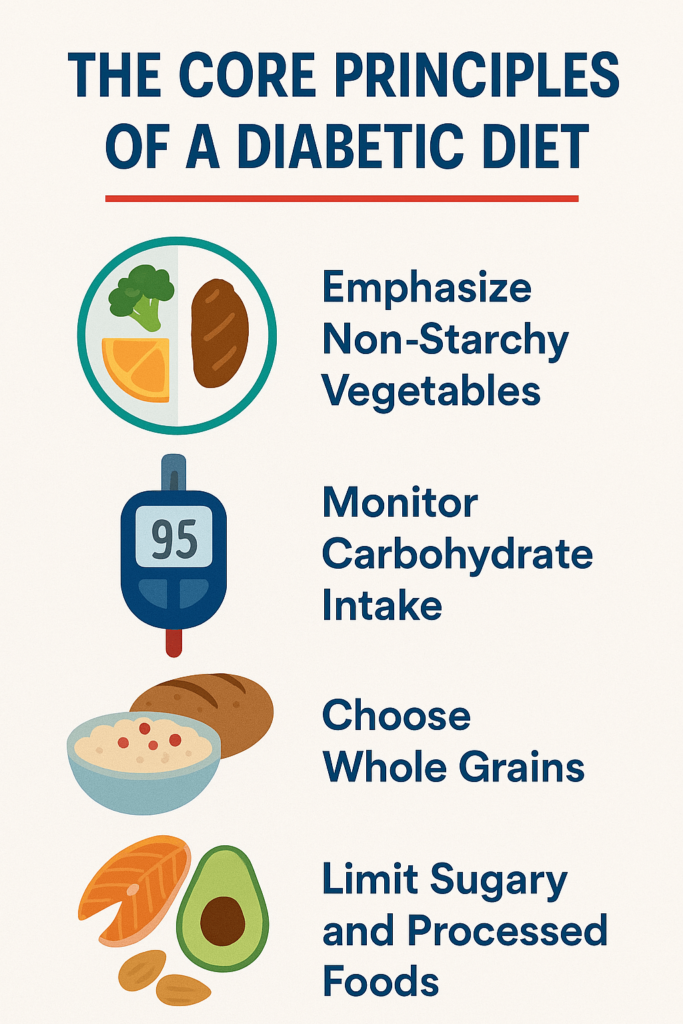
The Importance of a Balanced Diabetic Diet After 50
Why Diabetes Management Matters After 50
Diabetes becomes increasingly common as we age, and after the age of 50, it becomes even more important to carefully manage the condition through diet. Diabetes affects how the body processes glucose, and when not controlled, it can lead to serious complications like heart disease, kidney failure, and nerve damage. A proper diet, combined with lifestyle changes, can significantly reduce the impact of diabetes and help you maintain a good quality of life. By managing blood sugar through diet, you can take control of your health and avoid many of the complications associated with diabetes.
The Rising Prevalence of Diabetes in Older Adults
Diabetes is a growing concern for people over 50, with more than one in four adults over the age of 65 affected by the disease. The Centers for Disease Control and Prevention (CDC) reports that the number of older adults diagnosed with diabetes continues to rise, and many more are undiagnosed. The risk of developing type 2 diabetes increases with age due to factors like genetics, weight gain, lack of exercise, and a decline in the body’s ability to process glucose efficiently. However, the good news is that diabetes can be managed effectively with the right dietary and lifestyle interventions.
The Impact of Aging on Diabetes
Aging impacts diabetes management in several ways. As people age, their metabolism tends to slow down, making it more difficult to maintain a healthy weight. This, in turn, can increase the risk of developing insulin resistance—a condition where the body’s cells do not respond well to insulin. Additionally, muscle mass tends to decrease with age, which can negatively affect the body’s ability to regulate blood sugar. These changes mean that people over 50 need to be even more diligent about their diet and physical activity to prevent blood sugar from rising to unhealthy levels.
How a Proper Diet Can Improve Quality of Life
The right diet can improve both short-term and long-term health for diabetics. By stabilizing blood sugar levels, a balanced diet can help reduce common diabetes symptoms like fatigue, dizziness, and blurred vision. It can also lower the risk of diabetes-related complications, such as heart disease and nerve damage. A well-balanced diet helps maintain a healthy weight, improves energy levels, and supports overall well-being, allowing individuals to lead a fuller, healthier life. It is the foundation of managing diabetes effectively.
The Core Principles of a Diabetic Diet
A balanced diabetic diet is not just about reducing sugar intake. It’s about creating a comprehensive approach to eating that helps stabilize blood sugar, reduce inflammation, and promote overall health. This diet must be rich in whole foods, nutrient-dense ingredients, and a balance of macronutrients—carbohydrates, proteins, and fats.

The Role of Carbohydrates in Blood Sugar Control
Carbohydrates have the most direct effect on blood sugar levels. Carbs are broken down into glucose, which the body uses for energy. However, the rate at which carbs are digested and absorbed can affect blood sugar. Simple carbohydrates, like refined sugars, cause quick spikes in blood sugar, while complex carbohydrates, found in whole grains, legumes, and vegetables, release glucose more slowly, preventing sharp fluctuations in blood sugar. Therefore, the key is to focus on consuming healthy, fiber-rich carbs that help maintain steady glucose levels throughout the day.
How Proteins Support Muscle Mass and Metabolism
Proteins are essential for muscle maintenance and overall metabolism, particularly as we age. After 50, it’s crucial to maintain muscle mass because muscle helps the body process glucose more efficiently.
Eating enough lean protein sources, like chicken, turkey, fish, eggs, and plant-based proteins such as beans and lentils, helps support muscle growth and repair. Moreover, protein contributes to satiety, helping manage hunger and prevent overeating, which is particularly important for controlling blood sugar levels.
The Importance of Healthy Fats in a Diabetic Diet
Healthy fats are vital for hormone regulation, brain function, and maintaining a stable energy level. In a diabetic diet, healthy fats like omega-3 fatty acids found in fish, nuts, and seeds, and monounsaturated fats from olive oil and avocado, can help lower cholesterol, reduce inflammation, and support insulin sensitivity. Unlike unhealthy fats (saturated and trans fats), these fats do not raise blood sugar levels. Healthy fats also play a role in slowing down the absorption of carbohydrates, which can prevent blood sugar spikes.
Maintaining Blood Sugar Levels is Critical
Keeping blood sugar levels in check is one of the most important aspects of diabetes management. Uncontrolled blood sugar levels can lead to short-term symptoms like fatigue, blurry vision, and frequent urination, as well as long-term complications that affect the heart, kidneys, and nerves.
Why Stable Blood Sugar Matters
Stabilizing blood sugar is crucial for preventing both immediate discomfort and long-term complications of diabetes. High blood sugar levels over time can damage blood vessels and organs, leading to problems like diabetic retinopathy, neuropathy, and cardiovascular disease. Maintaining stable blood sugar levels through diet and other lifestyle changes helps mitigate these risks and reduces the need for medications or insulin.
The Dangers of Blood Sugar Spikes
When blood sugar spikes too high, it puts a strain on the body’s organs and increases the risk of long-term complications. Spikes often happen after consuming foods high in refined sugars and simple carbohydrates, which can rapidly increase glucose levels. This can lead to conditions like hyperglycemia, which, if left unmanaged, can cause irreversible damage to the body’s systems. Managing blood sugar levels by choosing nutrient-dense foods and avoiding processed sugars helps reduce these spikes and maintain a healthy glucose balance.
How Consistent Blood Sugar Helps Prevent Complications
Consistently keeping blood sugar in a safe range prevents the complications of diabetes from worsening. It helps preserve kidney function, protect the eyes from vision loss, and maintain nerve health. Consistency is key, and a well-balanced diet plays an integral role in achieving this. By stabilizing blood sugar levels through diet, people with diabetes can reduce their risk of developing more severe health issues down the road.
The Benefits of Meal Planning for Diabetics
Meal planning is an invaluable tool for anyone managing diabetes. It provides structure and consistency, helping you stay on track with your dietary goals and making it easier to choose healthier options.
Why Planning Meals Helps You Stay on Track
Meal planning helps take the guesswork out of eating. By preparing meals ahead of time, you ensure that your meals are well-balanced, nutrient-dense, and aligned with your blood sugar management goals. It also minimizes the temptation to indulge in unhealthy foods. Meal planning allows you to portion your meals accurately, making it easier to control calorie intake and avoid overeating, which can negatively affect blood sugar.
Simple Meal Planning Tips for Diabetics
Start by planning meals that feature a balance of healthy carbohydrates, lean proteins, and good fats. Focus on incorporating a variety of vegetables and whole grains, which provide fiber and nutrients. It’s also important to track your blood sugar levels to see how different foods affect your body.

Meal planning doesn’t have to be complex—simple, healthy recipes that can be prepped in advance can make a world of difference. You can find a more comprehensive meal planning guide in “Diabetic Diet After 50.”
How to Avoid Common Pitfalls with Meal Prep
A common mistake in meal prep is making the same meals repeatedly or relying on foods that aren’t filling or balanced. Ensure that your meals are varied and rich in all the essential nutrients. Avoid overly processed or high-sodium foods, and choose fresh ingredients whenever possible. Incorporating more plant-based foods, fiber-rich foods, and healthy fats can make your meal prep more satisfying and diabetes-friendly.
Practical Tips for Managing Diabetes Through Food
Managing diabetes involves not only choosing the right foods but also understanding how to balance them for optimal blood sugar control.
Balancing Your Plate: Carbs, Proteins, and Fats
A general guideline for a balanced diabetic plate is to fill half of your plate with non-starchy vegetables, a quarter with lean proteins, and a quarter with whole grains or other complex carbohydrates. This balance helps regulate blood sugar levels by preventing rapid glucose spikes while ensuring the body gets all the nutrients it needs.
The Role of Fiber in Managing Diabetes
Fiber is a key component of any diabetic diet because it slows the absorption of sugar into the bloodstream. High-fiber foods like beans, whole grains, fruits, and vegetables can help stabilize blood sugar levels and keep you feeling full longer. Fiber also supports healthy digestion and weight management, which are essential for managing diabetes effectively.
Portion Control and How It Affects Blood Sugar
Portion control is one of the most important factors in diabetes management. Eating larger portions, even of healthy foods, can cause blood sugar spikes. Learning how to recognize proper portion sizes, whether through measuring cups or visual cues, helps ensure you’re eating the right amount of food and controlling your calorie intake. Using the tools provided in “Diabetic Diet After 50” can make portion control easier to manage.
A Balanced Diabetic Diet Beyond Just Counting Carbs
A balanced diet for diabetics isn’t just about counting carbs; it’s about considering all nutrients that contribute to overall health and blood sugar regulation.
The Role of Micronutrients in a Diabetic Diet
Micronutrients, like vitamins and minerals, are essential for overall health and the proper functioning of the body. Nutrients like magnesium, vitamin D, and potassium can help regulate blood sugar, support heart health, and improve insulin sensitivity. Incorporating a variety of fruits, vegetables, and whole foods into your meals will ensure you’re meeting your micronutrient needs.
How to Include More Fruits and Vegetables
Fruits and vegetables are essential for a healthy, balanced diet. Diabetics should aim to include a variety of colorful vegetables and low-glycemic fruits like berries, apples, and pears. These foods are packed with fiber, vitamins, and minerals that help regulate blood sugar levels while providing the body with the nutrients it needs.
Staying Hydrated: Why Water Matters
Proper hydration is crucial for managing diabetes. Water helps regulate blood sugar levels and flush out excess glucose from the bloodstream. Dehydration can lead to higher blood sugar levels, so it’s important to drink enough water throughout the day to keep your body functioning at its best.
How to Get Started with a Diabetic Diet After 50
Adopting a diabetic-friendly diet doesn’t have to be overwhelming. Start small and gradually make changes to your eating habits.
The First Steps to Take
Begin by eliminating processed sugars and focusing on whole, nutrient-dense foods. Prioritize vegetables, lean proteins, and healthy fats. Slowly incorporate more fiber-rich foods into your diet, such as whole grains, legumes, and fruits. You can start by introducing one or two diabetic-friendly meals each week and work your way up from there.
Starting Small: Making Incremental Changes
You don’t have to change everything at once. Start with small changes—like swapping refined grains for whole grains or adding a serving of vegetables to each meal—and gradually increase your efforts over time. This approach makes the transition smoother and more sustainable.
The Importance of Consistency
Consistency is key when it comes to managing diabetes through diet. It’s not about perfection but about making healthy choices most of the time. Over time, these small, consistent efforts will help you maintain stable blood sugar levels and improve your overall health.
The Role of Support in Managing Diabetes
Having a support system makes it much easier to stick to a healthy diet and manage diabetes effectively.

Seeking Professional Help: Why a Nutritionist Can Be Your Best Friend
A registered dietitian or nutritionist can help you create a personalized diabetic diet plan that works for your specific needs. They can guide you on how to make healthy food choices, manage portion sizes, and find balance in your meals.
The Power of a Support System: Family and Friends
Having the support of family and friends can make managing diabetes easier. Whether it’s helping with meal prep, joining you for workouts, or just offering encouragement, a solid support system can keep you motivated and on track with your goals.
Conclusion
A balanced diabetic diet after 50 is essential for managing blood sugar levels, preventing complications, and maintaining overall health. By understanding the roles of carbohydrates, proteins, and fats, and committing to a structured meal plan, you can take control of your diabetes and live a healthier life.
Take Control of Your Health Today!
Ready to dive deeper into managing your diabetes with a balanced diet? “Diabetic Diet After 50” is the ultimate guide to maintaining healthy blood sugar levels, featuring over 120 delicious, easy-to-make recipes, a 4-week meal plan, and expert advice on how to live your healthiest life.
Don’t wait — start transforming your health now! Click below to take the first step towards a healthier future.
FAQs
What are the best foods to eat on a diabetic diet after 50?
The best foods include whole grains, lean proteins, healthy fats, vegetables, and low-glycemic fruits.
How can I prevent blood sugar spikes throughout the day?
Avoiding refined sugars and processed foods, focusing on balanced meals, and monitoring portion sizes can help prevent blood sugar spikes.
Is it possible to reverse type 2 diabetes with diet after 50?
While type 2 diabetes may not be fully reversible, it can be well-managed with the right diet and lifestyle changes.
How can I make meal planning easier for my diabetic diet?
Meal prep, using simple and balanced recipes, and planning ahead for the week can make meal planning easier and more manageable.
What are the long-term benefits of following a balanced diabetic diet after 50?
The long-term benefits include better blood sugar control, reduced risk of complications, improved energy levels, and overall health.




